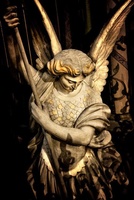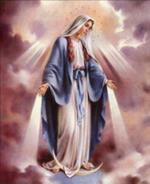Latest topics
Where is the one true Church of Christ?
2 posters
Extra Ecclesiam Nulla Salus Forum (No Salvation Outside the Church Forum) :: EENS Topics :: No Salvation Outside the Church
Page 1 of 1
 Where is the one true Church of Christ?
Where is the one true Church of Christ?
In his 1971 Catholic Catechism, Fr John Hardon asserts a fundamental continuity in the Church’s teaching on the Church:
The CDF Declaration Dominus Iesus magisterially affirms this same continuity:There is only one Church established by Christ; not only one but uniquely one. What, then, about the many “Churches” that we see in contemporary Christianity? Is the Roman Catholic Church only a Christian denomination, one of many branches of the Church, each of whom shares in a partial possession of Christ’s revealed truth and its own equally valid and effective means of sanctification?
For the first time in conciliar history, this issue was squarely faced and answered. The issue in question was not whether the Church is one. No believer in Christ would say otherwise. The issue was where this one Church of Christ can be found. The Second Vatican Council’s answer is unequivocal. That which constitutes the one true Church—its churchness, so to speak—not only exists but it subsists in the Catholic Church, which is governed by the successor of Peter and by the bishops in communion with him. Behind the carefully chosen verb “subsists” stands the affirmation that the objective fullness of Christ’s heritage to the Church—totality of his revelation, totality of his sacraments, and totality of authority to rule the people of God in his name—resides in the Catholic Church, of which the bishop of Rome is the visible head.
Other Christian bodies participate, in greater or less measure, of those elements of sanctification and truth that exist in their divinely ordained fullness (hence subsist) in the Roman Catholic Church. (p. 213)
The Lord Jesus, the only Saviour, did not only establish a simple community of disciples, but constituted the Church as a salvific mystery: he himself is in the Church and the Church is in him (cf. Jn 15:1ff.; Gal 3:28; Eph 4:15-16; Acts 9:5). Therefore, the fullness of Christ’s salvific mystery belongs also to the Church, inseparably united to her Lord. Indeed, Jesus Christ continues his presence and his work of salvation in the Church and by means of the Church (cf. Col 1:24-27), which is his body (cf. 1 Cor 12:12-13, 27; Col 1:18). And thus, just as the head and members of a living body, though not identical, are inseparable, so too Christ and the Church can neither be confused nor separated, and constitute a single “whole Christ.” This same inseparability is also expressed in the New Testament by the analogy of the Church as the Bride of Christ (cf. 2 Cor 11:2; Eph 5:25-29; Rev 21:2,9).
Therefore, in connection with the unicity and universality of the salvific mediation of Jesus Christ, the unicity of the Church founded by him must be firmly believed as a truth of Catholic faith. Just as there is one Christ, so there exists a single body of Christ, a single Bride of Christ: “a single Catholic and apostolic Church.” Furthermore, the promises of the Lord that he would not abandon his Church (cf. Mt 16:18; 28:20) and that he would guide her by his Spirit (cf. Jn 16:13) mean, according to Catholic faith, that the unicity and the unity of the Church—like everything that belongs to the Church’s integrity—will never be lacking.
The Catholic faithful are required to profess that there is an historical continuity—rooted in the apostolic succession—between the Church founded by Christ and the Catholic Church: “This is the single Church of Christ … which our Saviour, after his resurrection, entrusted to Peter’s pastoral care (cf. Jn 21:17), commissioning him and the other Apostles to extend and rule her (cf. Mt 28:18ff.), erected for all ages as ‘the pillar and mainstay of the truth’ (1 Tim 3:15). This Church, constituted and organized as a society in the present world, subsists in [subsistit in] the Catholic Church, governed by the Successor of Peter and by the Bishops in communion with him.” With the expression subsistit in, the Second Vatican Council sought to harmonize two doctrinal statements: on the one hand, that the Church of Christ, despite the divisions which exist among Christians, continues to exist fully only in the Catholic Church, and on the other hand, that “outside of her structure, many elements can be found of sanctification and truth,” that is, in those Churches and ecclesial communities which are not yet in full communion with the Catholic Church. But with respect to these, it needs to be stated that “they derive their efficacy from the very fullness of grace and truth entrusted to the Catholic Church.”
Therefore, there exists a single Church of Christ, which subsists in the Catholic Church, governed by the Successor of Peter and by the Bishops in communion with him. The Churches which, while not existing in perfect communion with the Catholic Church, remain united to her by means of the closest bonds, that is, by apostolic succession and a valid Eucharist, are true particular Churches. Therefore, the Church of Christ is present and operative also in these Churches, even though they lack full communion with the Catholic Church, since they do not accept the Catholic doctrine of the Primacy, which, according to the will of God, the Bishop of Rome objectively has and exercises over the entire Church.
On the other hand, the ecclesial communities which have not preserved the valid Episcopate and the genuine and integral substance of the Eucharistic mystery, are not Churches in the proper sense; however, those who are baptized in these communities are, by Baptism, incorporated in Christ and thus are in a certain communion, albeit imperfect, with the Church. Baptism in fact tends per se toward the full development of life in Christ, through the integral profession of faith, the Eucharist, and full communion in the Church.
“The Christian faithful are therefore not permitted to imagine that the Church of Christ is nothing more than a collection—divided, yet in some way one—of Churches and ecclesial communities; nor are they free to hold that today the Church of Christ nowhere really exists, and must be considered only as a goal which all Churches and ecclesial communities must strive to reach.” In fact, “the elements of this already-given Church exist, joined together in their fullness in the Catholic Church and, without this fullness, in the other communities.”
“Therefore, these separated Churches and communities as such, though we believe they suffer from defects, have by no means been deprived of significance and importance in the mystery of salvation. For the spirit of Christ has not refrained from using them as means of salvation which derive their efficacy from the very fullness of grace and truth entrusted to the Catholic Church.”
The lack of unity among Christians is certainly a wound for the Church; not in the sense that she is deprived of her unity, but “in that it hinders the complete fulfilment of her universality in history.”

MRyan- Posts : 2314
Reputation : 2492
Join date : 2010-12-18
 Re: Where is the one true Church of Christ?
Re: Where is the one true Church of Christ?
Wikipedia, to its credit, has an excellent article on this:
http://en.wikipedia.org/wiki/Subsistit_in
http://en.wikipedia.org/wiki/Subsistit_in

Jehanne- Posts : 933
Reputation : 1036
Join date : 2010-12-21
Age : 57
Location : Iowa
 Similar topics
Similar topics» The One True Church
» Pope Francis: Believing in Christ, but not in the Church is a contradiction
» Salvation "by" Christ without knowing Christ
» When Card. Ladaria and Bp Fellay meet a non Catholic they know he or she is oriented to Hell because the Church lic Church inspired by the Holy Spirit teaches this
» Infant mortality -- sad but true.
» Pope Francis: Believing in Christ, but not in the Church is a contradiction
» Salvation "by" Christ without knowing Christ
» When Card. Ladaria and Bp Fellay meet a non Catholic they know he or she is oriented to Hell because the Church lic Church inspired by the Holy Spirit teaches this
» Infant mortality -- sad but true.
Extra Ecclesiam Nulla Salus Forum (No Salvation Outside the Church Forum) :: EENS Topics :: No Salvation Outside the Church
Page 1 of 1
Permissions in this forum:
You cannot reply to topics in this forum
 Home
Home


» Defilement of the Temple
» Forum update
» Bishop Williamson's Recent Comments
» The Mysterious 45 days of Daniel 12:11-12
» St. Bonaventure on the Necessity of Baptism
» Isaiah 22:20-25
» Translation of Bellarmine's De Amissione Gratiae, Bk. VI
» Orestes Brownson Nails it on Baptism of Desire
» Do Feeneyites still exist?
» Sedevacantism and the Church's Indefectibility
» Inallible safety?
» Usury - Has the Church Erred?
» Rethink "Feeneyism"?
» SSPX cannot accept Vatican Council II because of the restrictions placed by the Jewish Left
» Anyone still around?
» Angelqueen.org???
» Vatican (CDF/Ecclesia Dei) has no objection if the SSPX and all religious communities affirm Vatican Council II (without the premise)
» Piazza Spagna - mission
» Fund,Catholic organisation needed to help Catholic priests in Italy like Fr. Alessandro Minutella